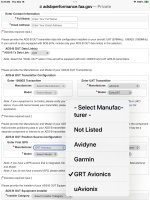charosenz
Well Known Member
USing a GPS for Echo besides skyfyx??? like GRT safe fly?
Anyone using a GPS that works with the Uavionix Echo besides the Skyfyx? I.E> GRT safe fly gps?
I have the Echo, but I do not have the SkyFyx. I know I could buy one used, but I was just wondering if there anyone is actually using a different GPS and of course is getting a passing PAPR.....
Anyone using a GPS that works with the Uavionix Echo besides the Skyfyx? I.E> GRT safe fly gps?
I have the Echo, but I do not have the SkyFyx. I know I could buy one used, but I was just wondering if there anyone is actually using a different GPS and of course is getting a passing PAPR.....
Last edited:





